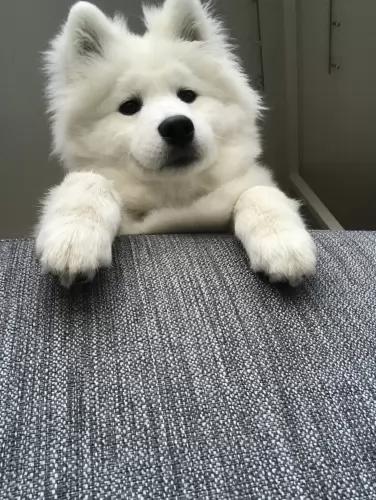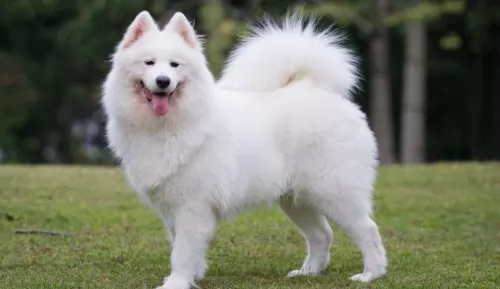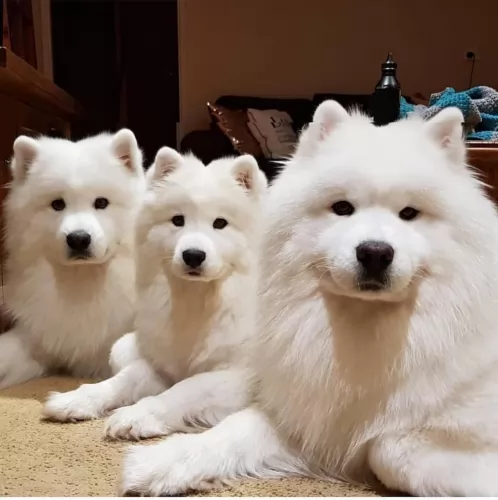 MyDogBreeds
MyDogBreedsBoth Samoyed and Moscow Guard dog are originated from Russia. Samoyed may grow 8 cm / 3 inches shorter than Moscow Guard dog. Samoyed may weigh 38 kg / 83 pounds lesser than Moscow Guard dog. Samoyed may live 3 years more than Moscow Guard dog. Both Samoyed and Moscow Guard dog has almost same litter size. Both Samoyed and Moscow Guard dog requires Moderate maintenance.
 The Samoyed is a large breed of dog; a spitz-type dog, with a thick, double-layer coat. The dog was used to help with herding and to also haul sledges for the Siberian Samoyede people.
The Samoyed is a large breed of dog; a spitz-type dog, with a thick, double-layer coat. The dog was used to help with herding and to also haul sledges for the Siberian Samoyede people.
The Samoyed has been used in polar expeditions, including Sir Ernest Shackleton's journey to the Antarctic. They’ve put up with a lot of hardships on these journeys and some of them have lost their lives on these expeditions.
The first standard for the breed was adopted in England in 1909, and in 1923 the original Samoyed Club of America was established.
Looking much like the Saint Bernard, the Moscow Guard Dog or Moscow Watchdog is large, descending from quite a few giant breeds such as the Saint Bernard, different Russian Hounds and the Caucasian Ovtcharka.
The dog has a gentle temperament. Known also as a gentle giant, the Moscow Guard Dog was developed in the Soviet Union and is fairly common in its native country.
The first US-born litter of Moscow Guard Dogs was born in 2015. The Moscow Watchdog hasn’t yet been recognized by the AKC.
 The Samoyed is a large herding dog standing at between 48 to 60cm in height and weighing 16 – 30kg. He has a thick, double layer coat that is silvery white.
The Samoyed is a large herding dog standing at between 48 to 60cm in height and weighing 16 – 30kg. He has a thick, double layer coat that is silvery white.
The top layer is fairly long and coarse. The dog sheds heavily once or twice a year, but the dog is described as being hypoallergenic.
The ears of the dog are typical spitz-like – erect. The eyes of the dog are almond in shape and while they are usually brown, they can sometimes be blue too. The tail is long and curls over the dog’s back. When these dogs sleep in the snow, you might notice the tail is folded so that it covers the dog’s nose.
The Samoyed is a friendly dog, to such an extent that you wouldn’t call him a good watchdog. They’re friendly dogs with happy expressions on their faces. They make great family pets and will get on well with children as well as other dogs in the home.
Like all dogs, the Samoyed will need early training and socialization to make him obedient and well rounded. He is intelligent and can easily learn a few basic commands.
The Moscow Watchdog is a large mastiff-type dog. He stands at between 64 and 69cm in height ad weighs in the region of 45 – 68kg. He has a thick coat which is medium length, he has floppy ears and a long, plumed tail. The most common colors for the Moscow Watchdog are red and white with a little bit of black and tan around the head.
He is quite a heavy shedder so regular brushing and grooming is recommended.
He takes his role seriously as guardian and protector of his human family.
Large dogs don’t usually live as long as smaller breeds, and with good care your Moscow Watchdog can reach between 9 and 11 years of age. If you want your dog to be a parent, the litter size you can expect is anything from 5 to 10 puppies.
The dogs were used for guarding purposes and they are strong-willed, dominant and independent. They are also gentle dogs but will still require training and socialization to make them obedient and an all-round pleasant dog.
While the Moscow Watchdog is described as a pleasant dog, he isn’t a friendly teddy-bear kind of dog, tending to be fairly aloof. He would do well with an owner who is firm, fair, consistent and strong, as he is strong-willed.
 The Samoyed is a gentle, easy going dog that gets on well with everyone, loving children and being prepared to be friendly towards other dogs too.
The Samoyed is a gentle, easy going dog that gets on well with everyone, loving children and being prepared to be friendly towards other dogs too.
His friendliness makes it that he doesn’t make a good watchdog. He is intelligent and can be trained to obey basic commands.
He loves plenty of exercise, after all he has always been a working dog. Apart from the coat which will require quite a bit of upkeep, the Samoyed is prepared to come into your home and make you a splendid pet and companion.
The Moscow Watchdog is a large dog and beautiful to look at. Even though he is large and strong, he is gentle and calm and makes a splendid pet.
Because of his large size he is better suited to life in the countryside or the suburbs as compared to smaller properties in the city. Their exercise needs will also need to be met such as a walk every day.
Think carefully before you take such a large dog into your home as he will require a lot of good food. Before investing in any dog, make sure that you have the means to provide him with an excellent home where he gets the best care, because he is willing to give you the very best of himself.
 Dogs can get diabetes just like people can. Diabetes is becoming more common in dogs as people try and feed their dogs ‘treats’ such as chocolates, biscuits and ice-cream.
Dogs can get diabetes just like people can. Diabetes is becoming more common in dogs as people try and feed their dogs ‘treats’ such as chocolates, biscuits and ice-cream.
Fortunately diabetes is manageable. Certainly, if you discover signs of diabetes in your pet, get him to the vet. The typical symptoms of diabetes in dogs are increased urination, increased thirst and weight loss. Cataracts and blindness can also occur.
Glaucoma is when there is increased pressure in the eye. It can be hereditary or secondary where there is decreased fluid in the eye because of other eye diseases. Symptoms include pain and even vision loss. It can be treated surgically or with eye drops.
This is an inherited condition in dogs where the thighbone doesn't fit properly into the hip joint. Some dogs will even have lameness in both rear legs. The vet will want x-rays to diagnose hip dysplasia. Unfortunately arthritis can also develop.
The Moscow Watchdog is a healthy dog breed, and with few inheritable health problems, you’re not likely to spend much at the vet with him.
Of course, any dog needs a good diet, adequate exercise, vaccinations, and parasite treatments to stay in top condition. Some of the common diseases to look out for -
We always have to mention hip dysplasia as it is so common with all dogs. Its an hereditary condition where lack of hip joint stability causes pain inflammation and lameness in the dog. Your dog, even though he is young, can develop hip dysplasia and then it can lead to early arthritis too. Your dog will need to get to the vet.
 The coat of the dog is super thick and in the Spring, the dog sheds a lot. Samoyed dog owners will need to be regular with their brushing routine with these dogs as the coat can easily tangle. Some people just prefer to get their Samoyed to a professional groomer.
The coat of the dog is super thick and in the Spring, the dog sheds a lot. Samoyed dog owners will need to be regular with their brushing routine with these dogs as the coat can easily tangle. Some people just prefer to get their Samoyed to a professional groomer.
This is a working dog, used to working hard in all kinds of conditions. He doesn’t take kindly to being bored with nothing to do and he howls and barks till you take him on a walk. He requires regular exercise such as hiking, ball games, running and swimming. It is why this dog isn’t suited to life on a small property in the city. He requires a large garden or farm and lots of exercise.
If you want your Samoyed to be healthy so that you’re not constantly at the vet, provide him with top quality food. It is always useful and convenient having commercially manufactured food but you want to vary the diet just a bit by providing some homemade food too.
If you boil chicken, brown rice or pasta and spinach, sweet potatoes and carrots in a pot you can chop it all up and freeze it and feed portions twice a week to your dog. Warmed up it can be added to his dry kibble and be a wonderful tasty treat for him. Every now and then you can also include some raw meat which can be beneficial for his skin. Ensure there is always a bowl of fresh, cool water within his reach.
This is a large breed dog so you want to make sure that if you feed him from the many commercially manufactured foods there are, it is the high quality one packed with vitamins and minerals and which cater specifically for large breeds to ensure the right amount of minerals and vitamins for his size.
You don’t want to just go on and on giving him dry kibble every day, so occasionally it will be a good idea to give him some boiled chicken, brown rice or pasta and some cooked vegetables which can be added into his kibble. This is all the variety your dog needs, as dogs like consistency and simplicity because then they don’t suffer with digestive issues.
Never leave him without a constant source of cool, fresh water.
Contrary to what this dog looks like – large and clumsy, he is actually quite agile and will require a good amount of exercise. He may not look particularly active but he will certainly want a daily walk and he will also require running off the leash in the park or some ball and rope games in the garden.
he Moscow Watchdog has a thick, medium length coat. He doesn’t require professional grooming, but a good brush through once a week will help to condition the coat. Also, the breed is a moderate shedder so removing loose hair keeps the coat shiny and healthy.